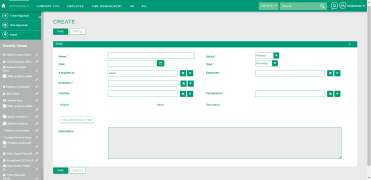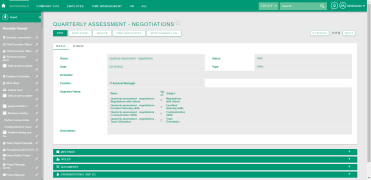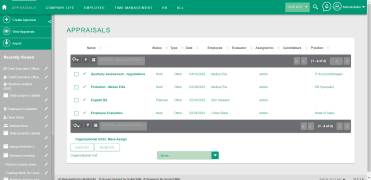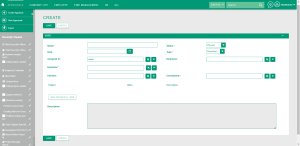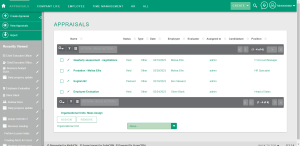Appraisals
| Appraisals | |
|---|---|
| Name: | Appraisals |
| Tech Name: | Appraisals |
| Class Name: | Appraisals |
| Type: | Standard |
| Template: | Security_groups, Employee_related, Assignable, Basic |
| Custom Module: | No |
| Auditable: | Yes |
| Importable: | No |
| Reportable: | Yes |
| Hide module on Main Page: | No |
Contents
Short Description
The Appraisals module is a tool primarily designed for HR professionals within the organization. It serves as a platform for storing assessments of candidates, allowing for a detailed evaluation process. With an expanded feature set, including the ability to add appraisal item fields dynamically, the Appraisals module offers flexibility in candidate assessment.
Overview
As a Human Capital Management (HCM) system, MintHCM has an extensive, bult-in module dedicated to perform an assessment of candidates or employees. Following article covers all the aspects related to the Appraisals module, the tool within the system, that allows users to thoroughly evaluate candidate or employee, provide detailed descriptions, establish connections with various assessment criteria, and gain a holistic view of a candidate's or employee's capabilities.
The Appraisals module follows a standard module structure, incorporating List, Detail, Edit, and other views typical to the system, that can be displayed within other modules. In this case, Edit/Create View adheres to a standard form structure, but it offers the flexibility to expand by incorporating additional fields when needed. Users can initiate this expansion by clicking the "ADD APPRAISAL ITEM" button, which triggers the appearance of an additional section containing relevant fields for the newly added appraisal item. Check the "Appraisal Items" section below for more information on this feature.
Standard Fields
The Appraisals module comprises several standard fields, each serving a specific purpose in capturing and organizing appraisal-related information. Here is a detailed explanation of each field:
| Name | Name of the appraisal record. Serves as a link to the record's detailed view from anywhere in the portal, including list view. | |
| Status | This dropdown field captures the current status of the appraisal. It offers a selection of predefined options: "Planned", "In progress", "Held" and "Not held". | |
| Date | The date on which the appraisal is conducted, providing a timestamp for reference. | |
| Type | This dropdown field captures the type of the appraisal. This dropdown field provides two options: "Recruiting" and 'Other' to separate appraisals related to a recruitment process from the ramaining appraisals that are being conducted in the organisation. Selecting "Recruiting" activates an additional field - "Candidature" to appear. Keep in mind that after selecting the "Recruiting" type, system won't allow you to save an appraisal record with other appraisal items than "Competency". | |
| Assigned to | Assigns responsibility to a specific user or team within the organization for overseeing the recruitment process. It ensures clear ownership and accountability for each recruitment record. | |
| Employee | Establishes a relationship with the Employees module, linking the appraisal record to the specific Candidature for which the appraisal is initiated. | |
| Evaluator | Establishes a relationship with the Users module, linking the appraisal record to the specific user to indicate a person who actually conducted the appraisal represented by this record. | |
| Position | Establishes a relationship with the Positions module, linking the appraisal record to the specific position that | |
| Candidature | Visible only if record's type has been set as "Recruitment". Establishes a relationship with the Candidatures module, linking the appraisal record to the specific Candidature for which the appraisal is initiated. | |
| Description | Allows users to provide additional context or details related to this particular application. It should include some additional information that is necessary to process the application properly, but has no designated field. In the "Description" field you can also include any other information that seem relevant to the created record. |
Note: Fields marked with an asterisk on the form are required. Saving the record without providing input to them beforehand won't be possible.
Appraisal Items
Below you'll find a description on how to create and review appraisal items that are closely related to the appraosal module records. Please keep in mind, that appraisals items are technically a standard, separate module and therefore it's been described in the saparate article on this wiki - Appraisal Items. Please check it out if you're interested in more details about it.
Adding an appraisal item
As mentioned, form of fields that makes a separate record within appraisal module can be expanded adequately to the specific appraisal process that it represents. By clicking "ADD APPRAISAL ITEM" button you can add another row of fields that contains information on a separate candidate or employee evaluation criteria. It consists of 3 fields:
- Subject - represents the criteria for which the individual is being assessed. Further details about the appraisal item's subject are provided in the subsequent paragraph.
- Value - actual score assigned to the individual being appraised for their performance in the selected criteria. It offers a dropdown list with a rating system, typically ranging from 1 to 5, including a 'N/A' (Not Applicable) option.
- Description - Additional text area where person responsible for conducting the appraisal can provide comments or remarks regarding this appraisal item. In other words it It serves as a flexible space for any information that seem relevant for the appraisal process.
Appraisal item's subject
The "Subject" field within the appraisal item servs as a key identifier for the criteria being evaluated. It is important to understand that this field operates as a flexible relationship field. In practical terms, this means that the "Subject" field cannot simply accept free-text input. Instead, it establishes a connection with one of the available modules within the system. Keep in mind that the "Recruitment" appraisal type may have positions only on "Competence" subject and system won't allow you to save a "Recruitment" type appraisal record with appraisal items other than that.
The modules to which the "Subject" field can relate are predefined and include:
To clarify, if a user wish to evaluate an individual's performance in a specific area, such as for instance "Spanish language proficiency," they must first access the corresponding module within the system that aligns with the subject matter. In this case, the most suitable module might be the "Skills" module, where a "Spanish language proficiency" record should be created. This record can then be selected as the subject of an appraisal item within multiple appraisal processes. This solution benefits with consistency of an appraisal processes and a possibility of easy comparisons to determine who possesses a particular skill or criterion most effectively, or to identify individuals with specific skills when needed.
Custom Actions
Processes
Related Processes
| Process | Short Description |
|---|---|
| Competencies and Skills | Management of employees' competences and skills |
Related Process Steps
Related Features
Affected by
Initiating
Related Integrations
Structure
Fields
| Name | Type | Required | Validations | Visible | Editable |
|---|---|---|---|---|---|
| Appraisal Items | function | No | Yes | Yes | |
| Assigned to | relate | No | Yes | Yes | |
| Candidature | relate | No | Yes | Yes | |
| Created By | relate | No | Yes | No | |
| Date | date | No | Yes | Yes | |
| Date Created | datetime | No | Yes | No | |
| Date Modified | datetime | No | Yes | No | |
| Description | text | No | Yes | Yes | |
| Employee | relate | No | Yes | Yes | |
| Employee ID | relate | No | Yes | Yes | |
| Modified By Name | relate | No | Yes | No | |
| Name | name | Yes | Yes | Yes | |
| Position | relate | No | Yes | Yes | |
| Status | enum | Yes | Yes | Yes | |
| Type | enum | Yes | Yes | Yes |
Relationships
| Laft | Type | Right | Short Description | Relationship |
|---|---|---|---|---|
| Appraisals | one-to-many | Appraisal Items | One Appraisals record can have many related Appraisal Items records, but a specific Appraisal Items record can be related to only one Appraisals record. | Relationship: Appraisals - AppraisalItems |
| Candidatures | one-to-many | Appraisals | One Candidature record can have many related Appraisals records, but a specific Appraisals record can be related to only one Candidature record. | Relationship: Candidatures - Appraisals |
| Employees | one-to-many | Appraisals | One Employees record can have many related Appraisals records, but a specific Appraisals record can be related to only one Employees record. | Relationship: Employees - Appraisals |
| Positions | one-to-many | Appraisals | One Position record can have many related Appraisals records, but a specific Appraisals record can be related to only one Position record. | Relationship: Positions - Appraisals |
| Users | one-to-many | Appraisals | Specific Sugar user can modify many account records, but specific account record last modification was performed by specific user. | Relationship: Users - Appraisals |
| Users | one-to-many | Appraisals | Specific Sugar user can create many account records, but specific account record can be created by only one user. | Relationship: Users - Appraisals |
| Users | one-to-many | Appraisals | Specific Sugar user can be assigned to many account records, but specific account record can only have one user assigned. | Relationship: Users - Appraisals |
